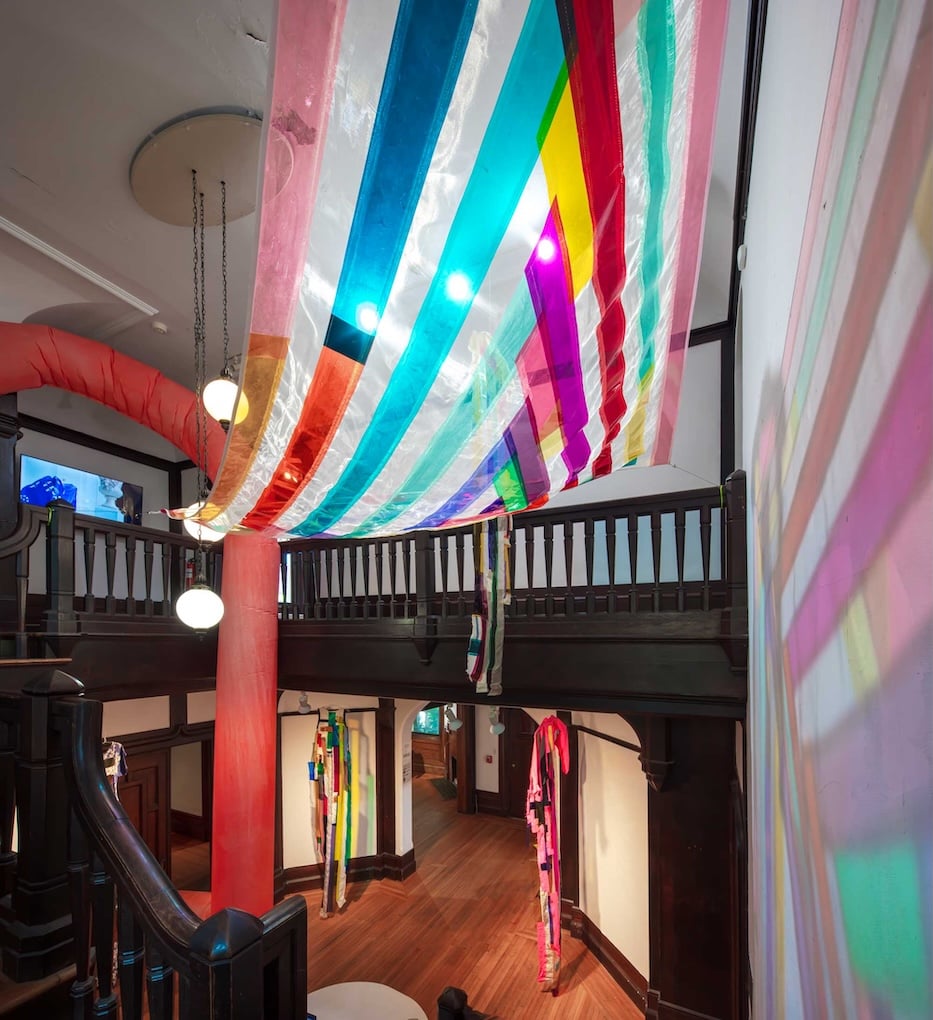
Culture & Community | Ely Center of Contemporary Art | Arts & Culture | Visual Arts

Peter Brown Photos.
A thin red thread pokes through a small hole in a transparent cloth, eventually emerging on the adjacent screen. The process repeats as the singular thread—opaque and bright—weaves in and out of the gauzy white fabric in a steady motion, changing in its opacity as it moves. The pace is slow, the feel of the fabric is soft, and the video seems to beckon attention on a banal repetitive action. This is Ann Hamilton’s meditative, two-channel video titled Thread Draw, portraying the slow rhythm of hand-sewing.
The compact screens of this intimate video contrast with many of the other large works in the sprawling group show, Body’s First Architecture. Curated by the artists Tamar Ettun and Leeza Meksin, the show continues through August 10 at the Ely Center of Contemporary Art (ECoCA). It centers textiles as a medium explored in a wide range of ways by more than 15 contemporary artists, including several works made by the curators.
Hamilton, who prefers the term “maker” over “artist,” inspired the title of the exhibition, clipped from an interview: “Textiles are the body's first house, the body's first architecture." Said another way, our bodies occupy our clothes more fully than the spaces we inhabit. Our clothes are a dwelling for the body.
It’s probably not lost on visitors that the connection between architecture and textiles starts before they enter this exhibition. Scaffolding enveloped in a scrim covers the exterior of the Ely Center of Contemporary Art. Outside the repurposed home, the beauty of the architecture is shielded from view, hidden by the apparent renovation efforts—an unlikely but timely draw to the show.

Peter Brown Photos.
At the exhibition’s core, Lilit’s umbilical cord—a large sculptural work by Ettun—snakes up the large central stairwell to the second floor of the early twentieth-century English Elizabethan style house. An air blower tucked into a dark corner on the first floor fills the sail cloth as it stretches upward, blocking a doorway with the jumbled tail of the form. Hand-dyed a soft pink, the long sewn tube seems to have the exact circumference of a toddler tunnel toy—a possible nod to the playfulness of this peculiar object.
Lilit’s umbilical cord has a corporeal vibe, perhaps playing into the curators’ desire to foreground the shared threads between textiles and the body's needs for healing. This exhibition posits textiles as a panacea for healing a chaotic world, and there are plenty of works on view here that exude a gentle, cushy aura. Rose Nestler’s It’s Ruff Out There and Leeza Meksin’s Harlequin Roll-up—found inside the same room on the first floor—are both defined by their neutral and pastel color palettes and lumpy-edged shapes.
But clothing can confuse and constrict, too. Molly Zuckerman-Hartung’s colorful assemblage adroitly wrestles with a muddle of emotions, rather than leaning too easily into the soothing aesthetic of soft power felt prominently throughout the show. By contrast, War Patterns (this is a weeping song) uses a drawing of a crying woman as its central motif.
This particular and twisted visage comes from Pablo Picasso’s Guernica. The artist’s infamous 1937 grisaille painting was a damning response to the Nazi’s horrific bombing of the eponymous town in the Basque Country in northern Spain. Composed of fabric scraps and screenprints made during Zuckerman-Hartung’s time at the Rauschenberg Residency at Captiva, the painting was recently pulled out of a box, patched with sheer silk in places, and restretched.

Peter Brown Photos.
Zuckerman-Hartung’s revived work is a standout within the exhibition, singular in its ability to merge craft and a wild spectrum of hyper-specific references. Art historical allusions cavort with mundane fabrics that feel plucked from the thrift store, all threatening not to gel. Vibrant patterns recall the dingey, cigarette smoke scented upholstery fabrics of the 70s or the jazzy trends of 90s rollerskating rinks.
Get too close and you may imagine you’re smelling stale popcorn and hearing Ace of Base. Taken together, the patterns romp through the material culture of recent decades at a dizzying clip, but stay grounded by the mournful image.
Textiles teleport. They travel with us into treacherous new realms, too. Enter VideoWear, a series dreamed up by Tali Hinkis and Kyle Lapidus. The New York-based interdisciplinary artist duo created a body of photographs in the early aughts that summon a retro-futuristic universe where technology has developed as an extension of organic systems. Four of these photographs are in the same upstairs room as Zuckerman-Hartung’s large wall piece.
Multi-colored threads encircle hands and legs spotted with small screens framed with rainbow fringe. These closely-cropped views of adorned and entangled body parts are set against a white void that feels like a marketing ploy. The blank backdrops give no indication of the future state of the world: is it grim, is it blinding? In this series, the fusion of the textiles and technology feels bespoke yet urgent, like the haphazard and insistent placement of safety-pins piecing punk rock clothes together.
Body’s First Architecture covers much ground, physically and metaphorically. Textiles form the crux of the show, which spans sculpture, installation, video, photography, painting, wearable art, and performance. The real zingers are the ones that pierce through the haze without preciousness, the works that utilize the textiles as a means to an end rather than the end itself.

Peter Brown Photos.
Body’s First Architecture continues through August 10, 2025, at Ely Center of Contemporary Art, 51 Trumbull St, New Haven, CT 06510.

